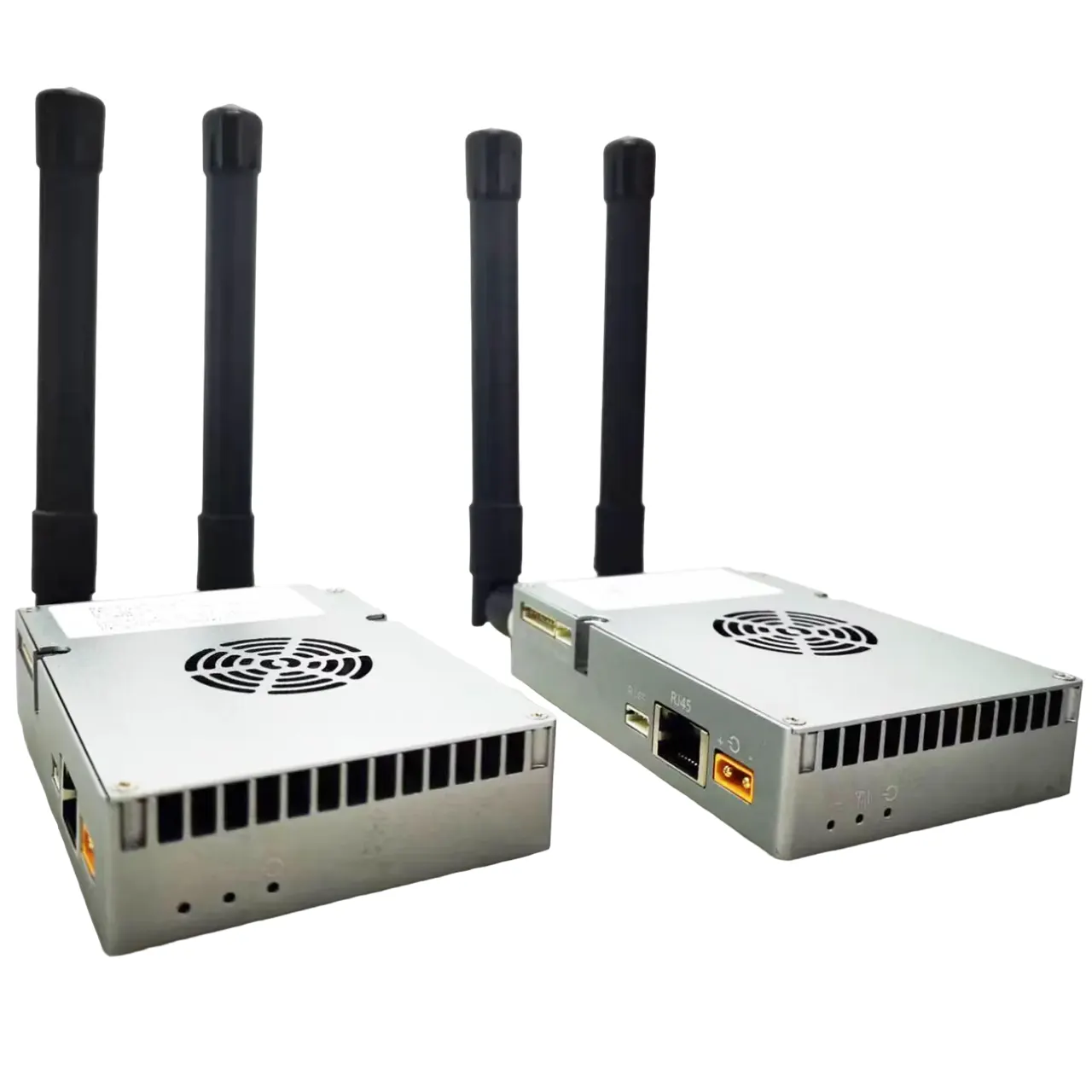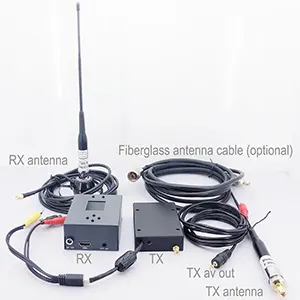Wireless Video Transmission RF Frequency Digital Down Converter COFDM Transfer frequency 2.4G to 600Mhz low BDC
Digital Down Converter
Wireless Video Transmission RF Frequency Digital Down Converter COFDM Transfer frequency 2.4G to 600Mhz low

Table of Contents
Selling Points
- Input frequencies from 24000 to 600MHz (Lower 1800Mhz)
- High bandwidth
- Low phase noise
- High-frequency stability

Specification
RF Frequency Range: 2400 Mhz
IF Frequency Range: 600 Mhz
Return Loss:-12 dB
Frequency Accuracy: ±10 ppm
Image Rejection: 60 dBc
Flatness: ±0.5 dB (8MHz bandwidth)
Conversion Gain: 25 dB
Phase Noise (dBc/Hz)
dBc/Hz@1KHz ≤-80
dBc/Hz@10KHz ≤-90
dBc/Hz@100KHz ≤-100
Supply Voltage: 10~15V
Power Current: 100 mA
Operating Temperature Range: +25 ℃

Port
RF IN: SMA-50K
IF OUT: SMA-50K
Power +12V: Stick
GND: Soldering lug
Note
- The converter does not need to add a low-noise amplifier at the back end.
- Actual Test: closed-loop test under the frequency of 2.4GHz/bandwidth 4MHz, the receiving sensitivity can reach -105dBm.
- Input frequency supports 1~3GHz. (We can help customize).
- Output frequency supports 300~700MHz. (We can support customize).
About the above video:
Our most popular products are wireless video transmitters and receivers. However, some clients require modification of the transmission frequency to meet local legal demand, in which case the digital frequency up-down converter block comes in handy. One customer requested that we customize the RF frequency down converter for his 2.4G wireless video transmitter. So the input frequency is 2.4GHz, the output frequency is 600MHz, and the lowdown frequency is 1800MHz. We created the sample in accordance with his specifications. So I showed him a simple video that showed the 2.4G transmitter and 600Mhz receiver working correctly. If you have a similar requirement, such as 1-3G frequency input and 300-700Mhz output, please contact us for a custom solution.


FAQs
A RF frequency block downconverter (BDC) for wireless video transmitters is a device that can convert a high frequency range to a low frequency range.
Typically used on the wireless video transmitter side. For example,
- From 5.8G to 2.4G down converter
- From 2.4G to 1.2G down converter
- From 1.2G to 600Mhz down converter
This is due to the fact that wireless transmission frequencies in many countries or regions are restricted by local laws and regulations.
It is not permitted to use in a specific frequency range.
To change the operating frequency of the transmitter and receiver, down-conversion or up-conversion is required. Make sure the transmission frequency is in accordance with local laws and regulations.
There is also the case where the professional receiving frequency is fixed, for example, between 300-800Mhz.
In order for the transmitter's frequency to be paired, the frequency of the 1.2G transmitter must be reduced.
All of this necessitates the use of a frequency downconverter for wireless video transmission.
Yes, our professional engineer replied, we can do it. And, before delivery, we will show you the test video.
Yes, our professional engineer confirms that we can re-design and modify some key components to do that. Sure, before delivery, we will show you the test video.
Thanks for your inquiry, I will check with our engineer.
Thanks for your inquiry. We can customize for you.
Please tell us the specification details of your transmitter and receiver modules.
Question: We are interested in n.1 downconverter from 950-1500 Mhz to 350-850 Mhz and n.1 upconverter from 350-850 Mhz to 950-1500 Mhz. Local oscillator 1800 Mhz.
Yes, Here is our specification for your references.
Frequency Down Converer Block specification sheet
|
Item |
Specification |
|
input frequency |
950 MHz ~1550 MHz |
|
output frequency |
350 MHz ~850 MHz |
|
Local frequency |
1800 MHz |
|
SPAN |
500MHz |
|
Noise Figure |
≤1.5dB |
|
gain |
25 dB |
|
Carrier leakage |
≤-20dBm |
|
Belt unevenness(8MHz) |
≤1.5dB |
|
IIP3: |
≥15dBm |
|
maximum input level |
-10dBm |
|
VSWR |
≤1.5 |
|
operation temperature |
-10~+60℃ |
|
voltage current |
12V/240mA |
|
RF Interface |
SMA-50KFD |
|
size |
108*48*15mm |
|
Power supply mode |
Socket power supply |

Frequency Up Converer Block specification sheet
|
Item |
Specification |
|
input frequency |
350 MHz ~850 MHz |
|
output frequency |
950 MHz ~1550 MHz |
|
Local frequency |
1800 MHz |
|
SPAN |
500MHz |
|
Noise Figure |
≤1.5dB |
|
gain |
25 dB |
|
Carrier leakage |
≤-20dBm |
|
Belt unevenness(8MHz) |
≤1.5dB |
|
IIP3: |
≥15dBm |
|
maximum input level |
-10dBm |
|
VSWR |
≤1.5 |
|
operation temperature |
-10~+60℃ |
|
voltage current |
12V/240mA |
|
RF Interface |
SMA-50KFD |
|
size |
108*48*15mm |
|
Power supply mode |
Socket power supply |
Question: If a signal of -25 dbm enter, what level has the coverterd output?
Answer: 0 dBm
What is DDC
In digital signal processing, a digital down-converter (DDC) converts a digitized, band-limited signal to a lower frequency signal at a lower sampling rate in order to simplify the subsequent radio stages. The process preserves all the information in the original signal less that which is lost to rounding errors in the mathematical processes. The input and output signals can be real or complex samples. Often the DDC converts from the raw radio frequency or intermediate frequency down to a complex baseband signal.
Architecture
A DDC consists of three subcomponents: a direct digital synthesizer (DDS), a low-pass filter (LPF), and a down sampler (which may be integrated into the low-pass filter). The DDS generates a complex sinusoid at the intermediate frequency (IF). Multiplication of the intermediate frequency with the input signal creates images centered at the sum and difference frequency (which follows from the frequency-shifting properties of the Fourier transform). The low-pass filters pass the difference (i.e. baseband) frequency while rejecting the sum frequency image, resulting in a complex baseband representation of the original signal. Assuming a judicious choice of IF and LPF bandwidth, the complex baseband signal is mathematically equivalent to the original signal. In its new form, it can readily be down-sampled and is more convenient to many DSP algorithms. Any suitable low-pass filter can be used including FIR, IIR, and CIC filters. The most common choice is an FIR filter for low amounts of decimation (less than ten) or a CIC filter followed by an FIR filter for larger down-sampling ratios.
Variations on the DDC
Several variations on the DDC are helpful, including many that input a feedback signal into the DDS. These include:
- Decision-directed carrier recovery phase-locked loops in which the I and Q are compared to the nearest ideal constellation point of a PSK signal, and the resulting error signal is filtered and fed back into the DDS
- A Costas loop in which the I and Q are multiplied and low pass filtered as part of a BPSK/QPSK carrier recovery loop
Implementation
DDCs are most commonly implemented in logic in field-programmable gate arrays or application-specific integrated circuits. While software implementations are also possible, operations in the DDS, multipliers, and input stages of the low-pass filters all run at the sampling rate of the input data. This data is commonly taken directly from analog to digital converters (ADCs) sampling at tens or hundreds of MHz. CORDIC is an alternative to the use of multipliers in the implementation of digital down converters.
Here is a client’s customized project, 1300~1400 Mhz input down converter to 300-400Mhz.


图传下变频器中国深圳供应商, 频率定制

名称: 图传下变频器
型号: LWDC-248258I
编号: 1805001
RF +12V IF
Name: RF Down Converter
Model: LWDC-3000I
Model: LWDC-1400
Frequency input 2G~2.7G(2000~2700Mhz)
Lower: 1800Mhz
Frequency output: 200Mhz-700Mhz
SN2405002
| MIN | TYPE | MAX | ||
| Operating frequency band (MHz) | 1300 | – | 1400 | 工作频段 (MHz) |
| Local oscillator (MHz) | 1000 | 本振(MHz) | ||
| Intermediate frequency (MHz) | 300 | – | 400 | 中频(MHz) |
| Conversion gain Gain(dB) | 18 | 20 | 22 | 变频增益Gain(dB) |
| Gain Flatness (dB) | ±1 | – | 增益平坦度(dB) | |
| Noise figure (dB) | 1.5 | – | 噪声系数(dB) | |
| Port Standing Wave Ratio VSWR | 1.5 | 1.8 | 2 | 端口驻波比VSWR |
| Port Impedance(ohm) | 50 | – | 端口阻抗(ohm) | |
| Maximum input power (dBm) | -5 | 最大输入功率(dBm) | ||
| Maximum output power (dBm) | 15 | 最大输出功率(dBm) | ||
| Working voltage (V) | 10 | 12 | 15 | 工作电压(V) |
| Operating current (mA) | 130 | 150 | 180 | 工作电流(mA) |
| Operating temperature (°C) | -25 | 55 | 工作温度(°C) | |
| Storage temperature (°C) | -45 | 65 | 存储温度(C) | |
| Dimension mm (without connectors) | 62x32x14mm | 尺寸 mm (不含连接器) |


Customize Frequency Specification Sheet Download
| Item | Parameter |
| input frequency | 2100 MHz ~2500 MHz |
| output frequency | 350 MHz ~750 MHz |
| Local frequency | 1750 MHz |
| Noise Figure | ≤1.5dB |
| gain | 15 dB |
| Carrier leakage | ≤-20dBm |
| Belt unevenness(8MHz) | ≤1.5dB |
| IIP3: | ≥15dBm |
| maximum input level | 0dBm |
| VSWR | ≤1.5 |
| operation temperature | -10~+60℃ |
| voltage current | ≤12V/240mA |
| RF Interface | N-50KFD |
| size | 108*48*22mm |
| Power supply mode | Online power supply |

Be the first to review “Wireless Video Transmission RF Frequency Digital Down Converter COFDM Transfer frequency 2.4G to 600Mhz low BDC” Cancel reply
Related products
Video Transmitter
Video Transmitter


















Reviews
There are no reviews yet.